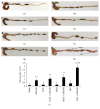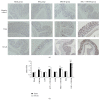κ-Carrageenan Enhances Lipopolysaccharide-Induced Interleukin-8 Secretion by Stimulating the Bcl10-NF- κ B Pathway in HT-29 Cells and Aggravates C. freundii-Induced Inflammation in Mice
- PMID: 28163398
- PMCID: PMC5253498
- DOI: 10.1155/2017/8634865
κ-Carrageenan Enhances Lipopolysaccharide-Induced Interleukin-8 Secretion by Stimulating the Bcl10-NF- κ B Pathway in HT-29 Cells and Aggravates C. freundii-Induced Inflammation in Mice
Abstract
Background. The dietary usage of carrageenan as common food additive has increased observably over the last 50 years. But there is substantial controversy about its safety. Methods. We investigated whether the κ-carrageenan could enhance lipopolysaccharide-induced IL-8 expression by studying its actions on the TLR4-NF-κB pathway. The aggravating effect of κ-carrageenan on Citrobacter freundii DBS100-induced intestinal inflammation was also investigated in a mouse model. Results. Our data show that κ-carrageenan pretreatment promoted LPS-induced IL-8 expression in HT-29 cells. Although CD14, MD-2, and TLR4 were upregulated, the binding of LPS was not enhanced. However, the pathway of Bcl10-NF-κB was triggered. Interestingly, κ-carrageenan competitively blocked the binding of FITC-LPS. Furthermore, pretreatment with κ-carrageenan for one week previous to gavage with C. freundii DBS100 markedly aggravated weight loss, mortality, and colonic damage. The secretion of cytokines was unbalanced and the ratio of Tregs was decreased significantly. In addition, κ-carrageenan, together with C. freundii DBS100, enhanced the transcription and secretion of TLR4 and NF-κB. Conclusions. κ-Carrageenan can synergistically activate LPS-induced inflammatory through the Bcl10-NF-κB pathway, as indicated by its aggravation of C. freundii DBS100-induced colitis in mice. General Significance. Our results suggest that κ-carrageenan serves as a potential inflammatory agent that magnifies existing intestinal inflammation.
Conflict of interest statement
The authors declare no conflict of interests, financial or otherwise.
Figures










Similar articles
-
Synergistic effect of κ-carrageenan on oxazolone-induced inflammation in BALB/c mice.BMC Gastroenterol. 2016 Mar 25;16:41. doi: 10.1186/s12876-016-0459-7. BMC Gastroenterol. 2016. PMID: 27015810 Free PMC article.
-
Degraded λ-carrageenan activates NF-κB and AP-1 pathways in macrophages and enhances LPS-induced TNF-α secretion through AP-1.Biochim Biophys Acta. 2014 Jul;1840(7):2162-70. doi: 10.1016/j.bbagen.2014.03.011. Epub 2014 Mar 16. Biochim Biophys Acta. 2014. PMID: 24641824
-
Bcl10 mediates LPS-induced activation of NF-kappaB and IL-8 in human intestinal epithelial cells.Am J Physiol Gastrointest Liver Physiol. 2007 Aug;293(2):G429-37. doi: 10.1152/ajpgi.00149.2007. Epub 2007 May 31. Am J Physiol Gastrointest Liver Physiol. 2007. PMID: 17540779
-
Carrageenan and TLR4 Crosstalk: A Comprehensive Review of Inflammatory Responses in Animal Models.Recent Adv Inflamm Allergy Drug Discov. 2025;19(1):5-17. doi: 10.2174/0127722708303188240708071523. Recent Adv Inflamm Allergy Drug Discov. 2025. PMID: 40195700 Review.
-
How does carrageenan cause colitis? A review.Carbohydr Polym. 2023 Feb 15;302:120374. doi: 10.1016/j.carbpol.2022.120374. Epub 2022 Nov 21. Carbohydr Polym. 2023. PMID: 36604052 Review.
Cited by
-
Food Additives Associated with Gut Microbiota Alterations in Inflammatory Bowel Disease: Friends or Enemies?Nutrients. 2022 Jul 25;14(15):3049. doi: 10.3390/nu14153049. Nutrients. 2022. PMID: 35893902 Free PMC article. Review.
-
Anti-colorectal cancer effects of seaweed-derived bioactive compounds.Front Med (Lausanne). 2022 Aug 19;9:988507. doi: 10.3389/fmed.2022.988507. eCollection 2022. Front Med (Lausanne). 2022. PMID: 36059851 Free PMC article. Review.
-
Dietary Carrageenan Amplifies the Inflammatory Profile, but not Permeability, of Intestinal Epithelial Cells from Patients With Crohn's Disease.Inflamm Bowel Dis. 2025 May 12;31(5):1392-1403. doi: 10.1093/ibd/izae306. Inflamm Bowel Dis. 2025. PMID: 39720875 Free PMC article.
-
Semi-refined carrageenan promotes generation of reactive oxygen species in leukocytes of rats upon oral exposure but not in vitro.Wien Med Wochenschr. 2021 Mar;171(3-4):68-78. doi: 10.1007/s10354-020-00786-7. Epub 2020 Oct 27. Wien Med Wochenschr. 2021. PMID: 33108805
-
Carrageenan as a Potential Factor of Inflammatory Bowel Diseases.Nutrients. 2024 Apr 30;16(9):1367. doi: 10.3390/nu16091367. Nutrients. 2024. PMID: 38732613 Free PMC article. Review.
References
-
- Watt J., Marcus R. Harmful effects of carrageenan fed to animals. Cancer Detection and Prevention. 1981;4(1-4):129–134. - PubMed
-
- Safety evaluation of certain contaminants in food. Proceedings of the 64th Meeting of the Joint FAO/WHO Expert Committee on Food Additives (JECFA '06); 2006; pp. 1–778. - PubMed
MeSH terms
Substances
LinkOut - more resources
Full Text Sources
Other Literature Sources
Research Materials

